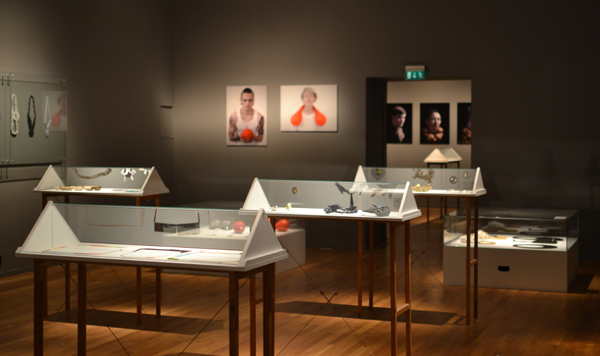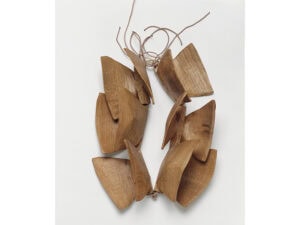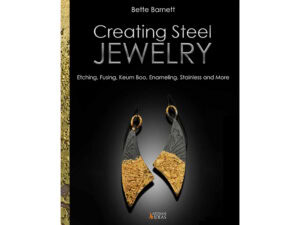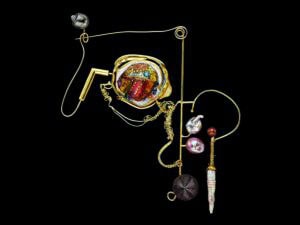This is the second in a new series called “in Sight.” We have asked a maker, a curator, and an historian to discuss From the Coolest Corner, an ambitious event that was just launched in Oslo, Norway. Märta Mattsson reported on the event as a visitor and exhibitor; Love Jönsson, who juried the main exhibition, took our written questions; and Liesbeth den Besten, who curated one of the shows, responded to a Skype interview after returning from Oslo. Mattsson, Jönsson, and den Besten went to Norway with a different job to do and together their reports produce a varied and complex snapshot of the event. We hope their overlapping voices, as well as those to come in this series, stir vigorous debate.
In 2011, Love Jönsson was appointed curator at the Röhsska Museum for Design, Fashion and Decorative Arts in Gothenburg, Sweden. Since 2005, he had been a visiting lecturer at the School of Design and Crafts, Gothenburg University. As a craft and design critic, Jönsson has been a prolific contributor to dailies and magazines in Sweden and abroad since the late 1990s. He has written essays for books and catalogs and was the editor of the anthology Craft in Dialogue: Six Views on a Practice in Change (Stockholm: Iaspis, 2005). A founding member of ThinkTank, a European Initiative for the Applied Arts, Love has also curated a number of exhibitions, including the 2012 Tallinn Applied Art Triennial The Art of Collecting. He was part of the jury for From the Coolest Corner.
Benjamin Lignel: The title of the exhibition suggests that the participating countries embrace a form of Nordic “esprit de corps,” and draw some of their strength from being on the geopolitical margin of the contemporary jewelry field. Do you think these assertions are true?
Love Jönsson: Actually, this is one of the topics intensely debated during the two-day conference at Oslo’s National Academy of the Arts that preceded the opening of From the Coolest Corner. My own opinion is that “Nordicism” does not exist in the works in the show. I don’t believe that many artists today, at least not in this part of the world, are interested in expressing national or regional identity for its own sake. I also doubt the very notion that artists could actually feel strengthened by the fact they are regarded as coming from the margins. That said, it should be noted that many artists use materials, motifs, and themes that have obvious connections to the Nordic countries, their nature and history. But rather than trying to revive the romantic “Nordicism” of the late nineteenth century, the work is about scrutinizing and playing with generalized views on the region and its identity.
Regarding the question of center and periphery, it is true that Scandinavia has been somewhat neglected in the European contemporary jewelry community. It has been surprisingly rare to see Scandinavian artists included in major international exhibitions, collections, and publications, with the exception of a small number of modernist stars such as Tone Vigeland (Norway), Björn Weckström (Finland), and Sigurd Persson and Tone Bülow-Hübe (Sweden), and contemporary artists such as Janna Syvänoja (Finland) and Tore Svensson (Sweden). This has changed considerably during the last decade, though.
Younger artists are eager to study abroad, to take part in various international collaborations, and to find an international audience for their work. I also see a new interest from galleries and collectors on the European continent and in United States for works from our region. They don’t look for “Nordic” jewelry, but simply for good pieces. For someone from another part of the world however, a touch of formal regionalism in the work—whether real or imagined—might seem attractive even if it does not reflect the intentions of the artists.

What was your impression of the work submitted to the jury? How did the show’s ambition—“to present the newest and most advanced contemporary Nordic jewelry”—translate into selection criteria?
The overall quality of the submitted works was very good. A common problem for juried exhibitions in any field is that many of the best artists will not apply. In this case, a majority of the artists I wanted to see in the show actually did apply. Some important artists did not send in an application, such as Terhi Tolvanen (Finland) for example. If I may take the liberty of mentioning one artist whose work I miss in the show, it is Tolvanen.
In terms of selection criteria, the jury looked for originality and innovation. This meant that works executed in the tradition of “Scandinavian Modern” were largely rejected. Some people might lament this, but the jury felt that the popular notion of Nordic jewelry as still rooted in a modernist tradition needs to be challenged, and thus we were keen on highlighting other facets of today’s scene.
Almost all my questions concern the issue of place, in part because of the exhibition’s title and in part because of the growing debate around the notion of international style versus culturally rooted work. Was this issue raised in the course of putting this exhibition together?
It does make sense today to talk about an international style of contemporary jewelry or perhaps about international styles in the plural. It isn’t always easy to give a written definition of these styles or approaches, but nevertheless they can be identified if you have seen a large enough selection of works from around the world. Some pieces in the show are international, others perhaps are more rooted in specific regional or local cultural contexts, and some are both. For example, I am thinking of Kajsa Lindberg’s works that deal with jewelry worn by historical persons as depicted on Swedish banknotes. The pieces demonstrate a conceptual and somewhat sociological approach to jewelry that focuses on social status and how jewels are worn and reproduced. This way of working belongs in the international mainstream of contemporary jewelry, but the artist’s references to Swedish banknotes and to famous historical Swedes links it to a more localized cultural environment.

In an essay written some time ago you endorsed artist-run initiatives, praising “flexible, non-institutional practices” in a world where “the major cultural institutions find themselves struggling to keep apace with the developments affecting them.” Yet most of the exhibition venues in the Oslo program are institutional. Do you think the divide between grassroots and institutional initiatives may be less prevalent today? Have institutions “caught up?”
Well, at least I think that museums and other major institutions are trying to catch up. From the Coolest Corner is organized by museums in Norway, Sweden, Finland, and Denmark together with artist organizations and art schools in these countries. The broad organizational structure behind the show makes itself heard perhaps not so much in the main exhibition as in the side programs of lectures and smaller shows being held in every city on the exhibit’s tour. It is true that many of the venues in Oslo were institutional, but several smaller exhibitions were staged in artist-run spaces.
You became curator at the Röhsska Museum for Design, Fashion and Decorative Arts a year ago. What do you think your role is with regard to the field(s) of contemporary craft? To document it? Stimulate it? Acquire it?
It is definitely to exhibit and acquire it, and partly to document it and conduct research. An overall task is to make contemporary jewelry more accessible to the general public through exhibitions and academic programs.
In terms of acquisitions, our museum collections are focused on Scandinavia, but we also buy international works from both younger and more established artists. This month, we are opening a small show that features jewelry added to the collection in the past five years. It includes works by Bettina Speckner, Manuel Vilhena, Lucy Sarneel, Lin Cheung, Gemma Draper, and Ulrich Reithofer.




